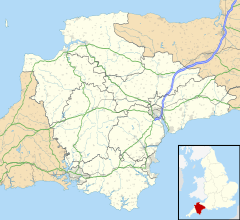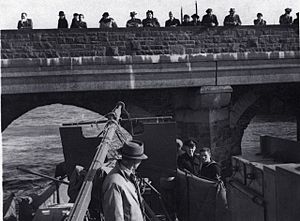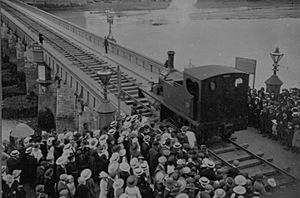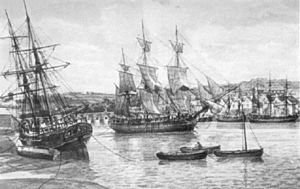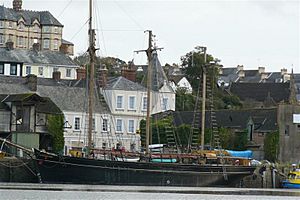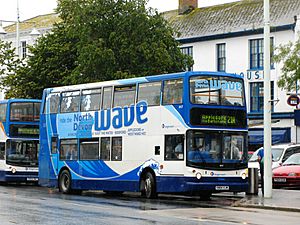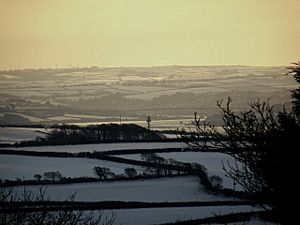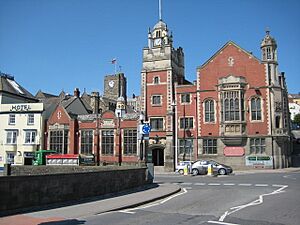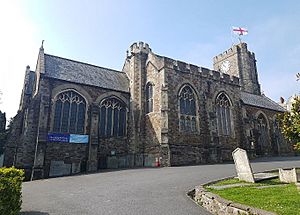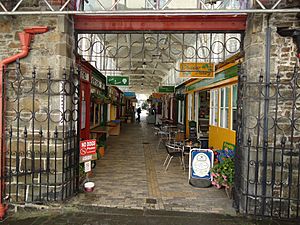Bideford facts for kids
Quick facts for kids Bideford |
|
|---|---|
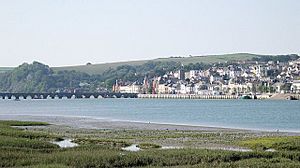 Bideford viewed looking westward across the River Torridge. Bideford Long Bridge is visible on the left |
|
 Coat of arms |
|
| Population | 18,260 (2021 Census) |
| OS grid reference | SS4426 |
| Civil parish |
|
| District |
|
| Shire county | |
| Region | |
| Country | England |
| Sovereign state | United Kingdom |
| Post town | BIDEFORD |
| Postcode district | EX39 |
| Dialling code | 01237 |
| Police | Devon and Cornwall |
| Fire | Devon and Somerset |
| Ambulance | South Western |
| EU Parliament | South West England |
| UK Parliament |
|
Bideford is a historic port town in Devon, South West England. It sits on the River Torridge estuary. This means the river meets the sea here. Bideford is the main town in the Torridge area.
Contents
- What's in a Name? The Meaning of Bideford
- Bideford's Long History
- Towns Named After Bideford
- Bideford Black: A Special Pigment
- How Many People Live in Bideford?
- Getting Around Bideford
- Bideford's Weather
- East-the-Water: A Part of Bideford
- How Bideford is Governed
- Schools in Bideford
- Places of Worship
- Bideford's Culture and Fun
- Sports and Fun Activities
- Famous People from Bideford
- See also
What's in a Name? The Meaning of Bideford
The name Bideford has been spelled in many ways over time. Some old spellings include Bedeford and Bydeford. The name means "by the ford." A ford is a shallow place in a river where you can walk across. Before the bridge was built, people could cross the River Torridge here at low tide.
Bideford's Long History
Early Days of Bideford
Long ago, a Viking leader named Hubba the Dane might have attacked this area. He was stopped by the Saxons.
The land of Bideford was listed in the Domesday Book in 1086. This was a big survey of England ordered by William the Conqueror. At that time, Bideford had 30 villagers and 14 slaves.

Later, the land was given to a powerful family called the Grenvilles. They owned Bideford for many centuries.
Bideford from 1500 to 1700
The Grenville family was very important to Bideford. They helped the town grow a lot. Sir Richard Grenville (1542–1591) was a famous member of this family. He was born in Bideford. He helped turn Bideford from a small fishing village into a busy trading port. It became known for importing tobacco from the new American colonies.

In 1585, Sir Richard Grenville's ship captured a Spanish ship. It brought back riches worth a lot of money to Bideford. He also brought a Native American man named Raleigh from Roanoke Island. Raleigh was baptized in Bideford but sadly died from illness.
During the English Civil War, Bideford supported the Parliamentarians. Royalist forces attacked and took over the town in 1643.
In 1646, a terrible plague killed many people in Bideford. It might have come from a Spanish ship. Later, French Protestants came to Bideford. They brought new skills like silk weaving.
The Bideford Witch Trial
In 1682, three women were accused of witchcraft in Bideford. Their names were Temperance Lloyd, Mary Trembles, and Susannah Edwards. This was one of the last times people were hanged for witchcraft in England.
Bideford in the 1800s and Early 1900s
In 1830, many people waved goodbye to ships leaving Bideford. These ships were going to places like New York City and Canada. Thousands of people emigrated from Bideford to Canada and the United States.
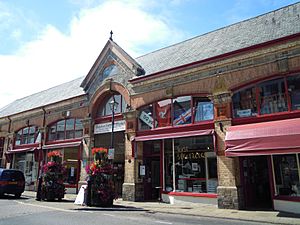
The Pannier Market opened in 1884. This was a big market hall. In 1902, the first car arrived in Bideford.
Bideford During World War II
American soldiers arrived in Bideford in 1942. They worked at radar stations and helped with secret experiments. More American troops came in 1943 to train for D-Day landings. This was a huge invasion of Europe.
The Americans had a large camp in Bideford with a cinema. They also used the Pill area for their forces. A Canadian bomber crashed in East-the-Water during the war. Three men died, and there is a memorial for them.
The Famous Long Bridge
The Long Bridge connects the two sides of Bideford across the River Torridge. The first bridge was built from wood in 1286. In 1474, a stone bridge replaced it. This is the bridge you see today. It has 24 arches, all different sizes! Some say each arch was paid for by a different local group. Others think they were built on natural rocks in the river.
The bridge was the longest in Devon in 1790. In 1925, a lorry fell off the bridge into the river, but the people inside survived. During World War II, the Home Guard patrolled the bridge to protect it. The bridge was repaired in 2008 to make it last another 60 years.
Bideford's Port and Shipping History
By the 1500s, Bideford was one of Britain's biggest ports. Sir Walter Raleigh brought his first tobacco shipment here. Bideford was also important for the Newfoundland cod fish trade. Many Bideford ships were involved in this trade.
Many ships were built in Bideford. The largest wooden ship was the Sarah Newman, built in 1855. Shipbuilding slowed down in the 1890s. This was because shipyards in other parts of Britain started building steel ships. Today, shipbuilding happens at Appledore Shipbuilders nearby. Bideford still exports clay and wood. The Kathleen and May, a famous old wooden ship, is registered in Bideford.
Recent History
Bideford Zoo opened in 1966 but closed in 1970. The area is now a housing estate.
Towns Named After Bideford
Other places around the world are named after Bideford. These include Biddeford, Maine in the United States. There is also a town called Bideford in Canada. And a small town in New Zealand is also called Bideford.
Bideford Black: A Special Pigment
Bideford Black is a unique black color. It was mined in Bideford for 200 years until 1969. This special pigment formed 350 million years ago! It contains carbon, silica, and alumina. The carbon gives it its black color. Bideford Black was used for many things. It was used as camouflage paint in World War II. It was also used in mascara by Max Factor. Artists used it in their paints. It was even used in the boat-building industry. Mining stopped because other black colors became cheaper to make. You can still see signs of the old mines in Bideford. Some roads are named after the mining, like Mines Road.
Recently, some Bideford Black was traded with Australian Aboriginal people. An Aboriginal elder's nephew used it to paint his body for ceremonies.
How Many People Live in Bideford?
In 2011, Bideford's population was 17,107 people. This was the highest it had ever been. The population is expected to keep growing.
| Historical population | ||
|---|---|---|
| Year | Pop. | ±% |
| 1991 | 13,006 | — |
| 2001 | 14,599 | +12.2% |
| 2011 | 17,107 | +17.2% |
Getting Around Bideford
Roads and Ferry
Bideford is connected by the A39 and A386 roads. A ferry boat travels from Bideford quay to Lundy Island. Lundy Island is about 22 miles away in the Bristol Channel. The same boat also offers evening cruises on the River Torridge.
Walking Paths
The South West Coast Path goes through Bideford. This long walking trail lets you explore the North Devon coast.
Buses
Buses connect Bideford to nearby towns. You can take a bus to Barnstaple, Torrington, and Westward Ho!.
Railway History
Bideford used to have a railway station. Passenger trains stopped running in 1965. The station building still exists and is looked after by a group called the Bideford Railway Heritage Centre. Much of the old railway line is now part of the Tarka Trail, a popular walking and cycling path.
The Bideford, Westward Ho! and Appledore Railway
There was once a special railway in Bideford. It was built only on this peninsula and didn't connect to other railways. The trains had skirts to protect people walking nearby. This railway was popular for visitors wanting to see the coast. It opened in 1901 and reached Appledore in 1908. During the First World War, the railway's equipment was sent to France. Bideford's Long Bridge was even used to move the trains onto the main railway line.
Bideford's Weather
Bideford has a mild and often wet climate. Winters are changeable, with mild, cloudy days and some frosty nights. Snow doesn't usually stay for long. Summers can be wet, but Bideford can also be one of the warmest places in Devon. In July 2022, temperatures reached 35 degrees Celsius during a heatwave.
| Climate data for Bideford, United Kingdom | |||||||||||||
|---|---|---|---|---|---|---|---|---|---|---|---|---|---|
| Month | Jan | Feb | Mar | Apr | May | Jun | Jul | Aug | Sep | Oct | Nov | Dec | Year |
| Record high °C (°F) | 16 (61) |
18 (64) |
20 (68) |
25 (77) |
27 (81) |
31 (88) |
35 (95) |
34 (93) |
28 (82) |
29 (84) |
18 (64) |
15 (59) |
34 (93) |
| Mean daily maximum °C (°F) | 8 (46) |
8 (46) |
10 (50) |
12 (54) |
16 (61) |
19 (66) |
21 (70) |
20 (68) |
19 (66) |
15 (59) |
11 (52) |
9 (48) |
14 (57) |
| Mean daily minimum °C (°F) | 4 (39) |
3 (37) |
5 (41) |
6 (43) |
8 (46) |
11 (52) |
14 (57) |
13 (55) |
11 (52) |
9 (48) |
6 (43) |
5 (41) |
8 (46) |
| Record low °C (°F) | −6 (21) |
−6 (21) |
−9 (16) |
−3 (27) |
0 (32) |
1 (34) |
6 (43) |
6 (43) |
−1 (30) |
−2 (28) |
−6 (21) |
−6 (21) |
−9 (16) |
| Average rainfall mm (inches) | 75 (3.0) |
46 (1.8) |
57 (2.2) |
54 (2.1) |
36 (1.4) |
51 (2.0) |
64 (2.5) |
45 (1.8) |
63 (2.5) |
93 (3.7) |
75 (3.0) |
81 (3.2) |
740 (29.2) |
| Average rainy days | 5 | 5 | 6 | 4 | 4 | 4 | 4 | 5 | 5 | 4 | 4 | 3 | 53 |
| Source 1: Weather2 | |||||||||||||
| Source 2: HolidayCheck.com | |||||||||||||
East-the-Water: A Part of Bideford
Bideford has grown to cover both sides of the River Torridge. The area on the east side is called East-the-Water. Much of this area was once marshland. East-the-Water has its own primary school, shops, and pubs. It also has a community center. A historical site here is Chudleigh Fort. It was built during the English Civil War.
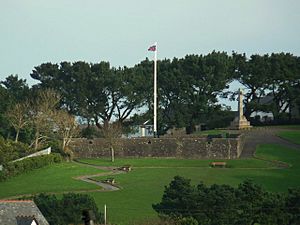
How Bideford is Governed
Bideford has a Town Council that makes local decisions. It has 16 members. The Town Council is based at Bideford Town Hall. There is a mayor and a Town Clerk. The Torridge District Council and Devon County Council also help govern the area.
Schools in Bideford
Bideford has several primary schools. These include East-the-Water Primary School and St. Mary's Church of England Primary School. Bideford College is the main secondary school for the area. Kingsley School is a private school in Bideford. It was formed in 2009 when two other schools joined together.
Places of Worship
Bideford has many churches. St Mary's Church is a large Church of England church. Its tower has a clock that can be seen across town. The church was rebuilt in 1862-65. Other churches include Bideford Baptist Church, Abundant Life Church, and Lavington United Reformed Church. There is also a Catholic church, a Free Church, a Methodist church, and an Evangelical Chapel. The Religious Society of Friends (Quakers) have a Meeting House. In 2011, most people in Bideford said they were Christian.
| Religion | Percentage of Bideford Population |
|---|---|
| Christian | 61.8% |
| Buddhist | 0.3% |
| Muslim | 0.2% |
| Hindu | 0.0% |
| Jewish | 0.0% |
| Sikh | 0.0% |
| Other religion | 0.7% |
| No religion | 28.6% |
| Religion not stated | 8.4% |
Bideford's Culture and Fun
New Year Celebrations
Bideford is famous for its New Year's Eve parties. Thousands of people, many in fancy dress, gather on the quay. They enjoy music and a fireworks display. There's also an old custom called Andrew's Dole. Since 1605, bread has been given to poor, elderly people on New Year's Day.
Local Media
Local radio used to be provided by Lantern FM. It later became part of Heart Devon. Now, a new local station called The Voice broadcasts across Devon. Local news is shown on BBC South West and ITV West Country. Bideford has two main local newspapers, the North Devon Gazette and the North Devon Journal.
Twin Towns
Bideford is twinned with Landivisiau in France. This means the towns have a special friendship. Bideford also has a link with Manteo, North Carolina in the United States. This link goes back to the 1500s. Many early settlers from Bideford went to Roanoke Island near Manteo.
Art and Creativity

Bideford Art School was open for many years. Today, the building is the Bideford Arts Centre. The Burton at Bideford is an art gallery and museum. It shows local art and things from Bideford's history.
Bideford Film Society
The Bideford Film Society started in 2001. It shows movies soon after they are released in cinemas. The films are shown at Kingsley School or Bideford College.
Markets and Shopping
Bideford has had markets since 1272. The current Pannier Market opened in 1884. It has a large hall for markets and events. Butchers Row has small shops and galleries. A farmers' market is held on the quay almost every Saturday in summer. A continental market also visits Bideford each year. Bideford has many small shops. Affinity Devon is a large outlet shopping center on the edge of town. Next to it is Atlantic Park, with restaurants and supermarkets.
Sports and Fun Activities
Bideford has two King George V Playing Fields. These are memorials to King George V. One field is home to the local rugby union club, Bideford RFC. The other field is home to Bideford AFC, the town's main football club. They have never been relegated in over 60 seasons! East-the-Water also has its own football club, Shamwickshire Rovers FC. There are also cricket clubs and two bowling clubs in Bideford. The North Devon Display Gymnastic Club is in town too. Bideford has hosted parts of the Tour of Britain cycling race. In 2012, the Olympic torch relay passed through the town. Many people came out to watch.
Famous People from Bideford
Many interesting people have connections to Bideford:
- Henry de Bracton, a 13th-century priest and lawyer, lived here.
- Sir Richard Grenville (1542–1591), the famous captain, was born in Bideford.
- Elisabeth Pepys, who married Samuel Pepys, was born in Bideford in 1640.
- Mathematicians Abraham Donn and Benjamin Donn were from Bideford.
- Admiral Bedford Pim was born here in 1826.
- Edward Capern (1819–1894), known as "the rural postman of Bideford," was a poet.
- The artist Bertram Prance was born here in 1889.
- Sir John Nott, a former Secretary of State for Defence, was born in Bideford in 1932.
- Cricket umpire David Shepherd was born here in 1940.
- The actress Joanna Tope was born in Bideford in 1944.
- Paul Seed, a television director and actor, was born here in 1947.
- Crime writer Hilary Bonner was born and grew up in Bideford.
- Graham James, a former Bishop of Norwich, was born here in 1951.
- John Richards, an electronic musician, was born in Bideford.
- Footballer Gary Sawyer was born in Bideford in 1985.
- Actor Joss Ackland lived near Bideford.
- T. V. Smith and Gaye Advert from the punk band The Adverts live here.
- Golfer Jimmy Mullen is from Bideford.
- Chris Busby, an environmental scientist, lives in Sir Richard Grenville's birthplace.
- Peter Christie, a local historian and councillor, was Britain's first Green Party mayor.
See also
 In Spanish: Bideford para niños
In Spanish: Bideford para niños


